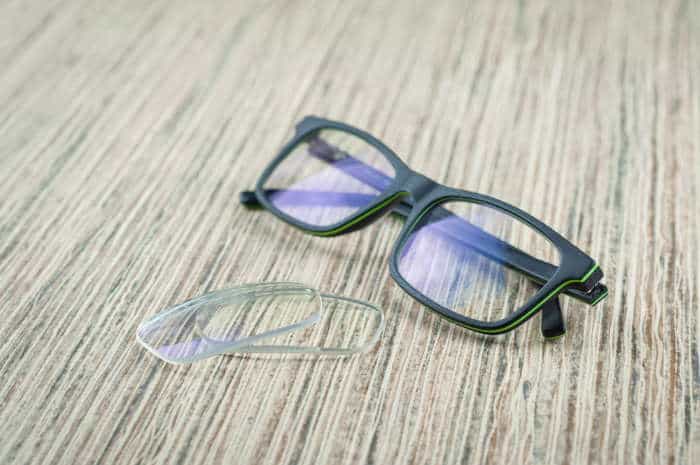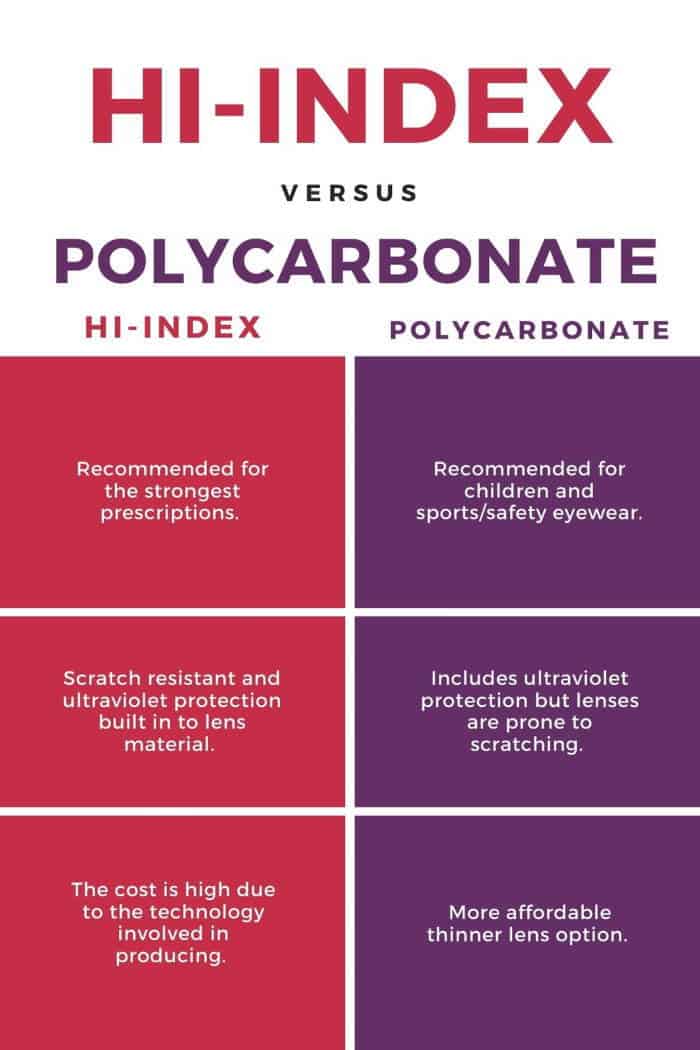
(This page contains affiliate links. OGR may receive compensation if you click a link and make a purchase.)
Choosing the right eyeglass lens can be a stressful task. With so many options on the market, it’s hard to know which one is best for you.
We’ll take you through some of the most popular types, including hi-index lenses and polycarbonate lenses, so you can make an informed decision about which type works best for your prescription and lifestyle.
Understanding your lens options is as simple as Basic, Better, and Best.
Basic
Standard Lenses
Standard plastic is a basic lens option offered in most entry-level lens packages. This type of lens is often referred to as CR-39 plastic.
These lenses are affordable because they don’t include any extras such as scratch-resistant or ultraviolet coatings.
You can order these coatings at an additional cost – which is often recommended to make your lenses more durable and protective.

Though if you’re in the market for prescription sunglasses, standard plastic lenses are very easy to tint and are the best choice for lower prescriptions.
One of the biggest drawbacks to standard plastic lenses is their lens thickness. Regular CR-39 plastic tends to be 25% to 50% thicker than other lens options. That’s why regular plastic lenses are recommended for lower prescriptions, around +2.00 to -3.00 or lower.
Better
Polycarbonate Lenses
Polycarbonate is a different type of lens material that’s thinner and lighter than regular plastic.
On average, polycarbonate lenses are about 20% thinner than CR-39. One of the great things about polycarbonate is that it has ultraviolet protection built into the material.

Polycarbonate is also extremely impact-resistant and therefore always recommended for children and all forms of safety glasses. Even though the lens is very impact-resistant, the material itself is pretty soft and is prone to scratching.
The cost of polycarbonate lenses is slightly higher than regular plastic, but you should purchase a scratch-resistant coating for added protection.
On the downside, polycarbonate is not the best choice if you want to tint your lenses. They can be lightly tinted but will not accept a very dark tint color.
A polarized lens option would be better if you require full sun protection in your polycarbonate sunglasses.
Strength-wise, polycarbonate is suitable if your prescription is -3.50 or lower and no higher than +2.50. This lens type also works great for any rimless frame requiring grooved or drilled lenses.

Best
Hi-Index Lenses
Hi-index lenses are on the high end of the lens spectrum, both in quality and pricing. Within this group, we can also describe different tiers of hi-index as basic, better, and best.
Hi-index lenses are identified by their refractive index number. The refractive index measures how much light is bent or refracted while passing through the lens.
The higher the refractive index of a lens, the more it will bend light, resulting in better visual clarity at all distances.
An easy way to remember this: the higher the index, the thinner your lens will be.
Thin – 1.61 Hi-Index (Basic)
This lens material is suitable for prescriptions from +2.00 to -4.00 and astigmatism correction of -3.00 or less.
1.61 Hi-Index is on average 25% thinner than CR 39.
Thinner – 1.67 Hi-Index (Better)
Recommended for prescriptions from +3.00 to -7.00, and astigmatism correction between -3.00 and -4.00.
1.67 Hi-Index is on average 30% thinner than CR 39.
Thinnest – 1.74 Hi-Index (Best)
These lenses are the thinnest and recommended if you have a strong prescription ranging from +3.00 to -7.00 or higher, and astigmatism correction powers over -4.00.
1.74 Hi-Index is 35% thinner than CR 39.
Hi-Index lenses are a must have for higher prescriptions. Ordering hi-index will dramatically reduce lens thickness and the overall weight of your eyewear.
The thinnest lenses possible are achieved by flattening the curves on the lens surface during manufacturing. This process results in an aspheric lens.
Aspheric lenses make a big difference in almost all prescriptions but are especially effective for farsighted (convex or “plus”) powers.

Convex lenses are thicker in the center and tend to make the eyes look very magnified. Using an aspheric lens reduces the center thickness dramatically and gives the eyes a more natural appearance.
Anti-reflective coatings should be applied to all hi-index lenses as they tend to reflect up to 50% more light than regular plastic lenses. The addition of the coating will decrease glare and help to achieve the best vision possible.
Besides lens choice, frame selection is also very important when trying to achieve the best-looking glasses with a high prescription.
To ensure you get the thinnest lenses possible, select a frame where the eyes are centered in the lens.
Strong nearsighted lenses are thick at the edges and thin in the middle. By choosing a smaller frame, you will eliminate the thicker edges and end up with an overall better looking pair of glasses.

FAQs
Are Hi-Index Lenses Better Than Polycarbonate?
High-index lens materials are the best option for stronger prescriptions, as they are thinner and lighter. However, polycarbonate is more impact-resistant, making them a better choice for sports, children’s frames, and safety glasses.
Are Hi-Index Lenses Worth The Extra Cost?
High-index lenses do cost more than polycarbonate lenses. However, people with strong prescriptions will likely find the additional cost worth it since high-index lenses are much thinner, lighter, and aesthetically pleasing.
My Prescription Is Not That Strong. Do I Really Need To Pay For A Hi-Index Lens?
If your prescription is +2.00 to -3.50, plastic CR-39 or polycarbonate lenses will work just fine. However, if you want a slightly thinner lens, polycarbonate would be the best option.
Why Are High-Index Lenses So Expensive?
New digital versions of hi-index lenses are computer-generated and custom tailored to your prescription and frame measurements.
By paying more for a thinner lens, you can choose from a larger selection of frames without worrying if your lenses will be too thick. As a result, Hi-Index lenses offer a superior visual experience and ultimately the best looking pair of glasses.
Cynthia is a published author and freelance writer that has enjoyed a career in the eyewear industry for more than 25 years. In 2016, she decided to combine her passion for writing with her experience as an Optician and launch her company, Pizzini Writes. She now dedicates her days to writing about the latest optical-related news and trends for various publications and independent retailers.
Learn more about her at www.pizziniwrites.com